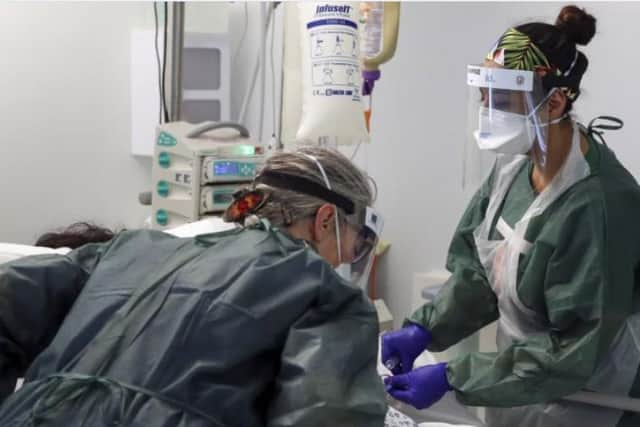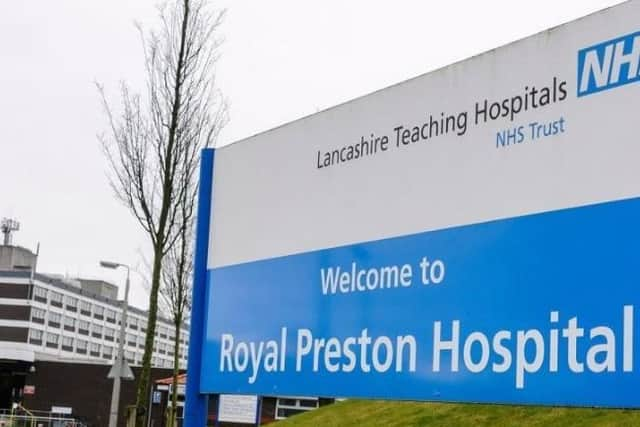Covid rollercoaster now approaching second peak in Preston - and it could be higher than the first
and live on Freeview channel 276
Latest figures released by health chiefs show the number of confirmed cases being treated in Lancashire’s major trauma centre is now into three figures and rising.
Of the 114 coronavirus patients currently occupying beds at RPH and Chorley Hospital, 14 are in critical care, filling half of the unit’s capacity.
Advertisement
Hide AdAdvertisement
Hide AdAnd with a number of the other ICU beds being taken up by non-Covid patients, there are worries the hospital’s high-dependency facilities are fast becoming stretched - something which may have an impact on elective surgery if availability of places becomes critical.


One member of staff said: “At the moment we can cope. But right now we are still continuing with elective surgery and other types of work that occupy critical care beds.
“But what could happen if Covid carries on getting worse is it could result in elective and non-urgent work being postponed. Hopefully that won’t happen.”
But other medics at RPH say ICU has come under so much pressure at times during this second wave that it has had to overflow into a geriatric ward, reducing the number of ordinary beds available at the hospital for elderly non-Covid patients.
Advertisement
Hide AdAdvertisement
Hide AdThe statistics have come from a stark letter written to all staff by chief executive Karen Partington this week. In it she reveals the total number of coronavirus deaths recorded by the Lancashire Teaching Hospitals Trust, which runs RPH and Chorley, has now reached 272 since the start of the pandemic.


On a brighter note, 787 Covid patients have been discharged back home since the first cases were reported back in early March.
At the peak of the first wave in April there were 11 patients on ventilators. Currently it is thought not all 14 Covid ICU cases require mechanical ventilation, but they still need some kind of respiratory support.
The predicted second spike of infections hit Lancashire at least a month ago and has been rising ever since.
Advertisement
Hide AdAdvertisement
Hide AdOn September 21 the county’s director of public health Dr Sakthi Karunanithi announced: “I believe that in Lancashire the second wave has arrived. If we don’t act now it is going to get a lot worse.”
At that time there were 121 new cases of the disease reported across the county in a 24-hour period. Now, a month on, the rising tide is seeing 10 times that number in a single day.
According to Public Health England, the total of confirmed cases of Covid-19 in Lancashire on October 6 stood at 15,570. On Tuesday, just two weeks on, that figure had soared to 24,632 and was rising at almost 900 a day.
So far Preston has seen the second highest number of cases overall with 3,857 according to the latest set of published figures. Blackburn with Darwen has the most with 4,604 and Burnley is in third place with 2,646.
Advertisement
Hide AdAdvertisement
Hide AdAcross the county, up until Tuesday this week, there had been 24,632 confirmed cases since the first ones - a couple in South Ribble - were diagnosed in early March.
Local lockdown, which came in at the beginning of September in Preston, appears to have had little or no effect on the rising numbers of Covid cases.
The whole of Lancashire was subsequently put on further restrictions three weeks later in the hope that would halt the spread. But last Saturday the county was moved up to the highest level of lockdown - Tier 3 - in a desperate attempt to bring the numbers of cases back down. The outcome of those extra measures is not expected to be seen for two or three weeks.
Dr Geraldine Skailes, medical director at Lancashire Teaching Hospitals, said: “Over recent weeks we have seen a significant rise in the number of Covid positive in-patients in our beds, including those in critical care and this is set to continue over the coming weeks.
Advertisement
Hide AdAdvertisement
Hide Ad“As a trust we have planned for this and it’s important to highlight that our hospitals are still here for you.
“Please still seek help if you need it, or continue with any treatment that is underway or planned. We have lots of measures in place to make sure that this is safe for you.
“We know that some people have already been waiting a long time for their care because of the pandemic – and we’ve been working hard to continue with services – but this becomes harder as Covid starts to create more pressure in hospitals again.
“We would encourage everyone to adhere closely to all local restrictions, and follow national guidance to reduce the spread of coronavirus to keep themselves and the community safe.”
Advertisement
Hide AdAdvertisement
Hide AdThe stark reality of the effect the second wave is having on Preston and Chorley Hospitals comes in a set of statistics gathered over the past month.
On September 18, the Lancashire Teaching Hospitals Trust had just eight Covid patients under treatment, with only one of those being looked after in critical care. Fast forward to October 6 and the numbers had grown to 32 patients with eight in critical care.
Two days ago, according to the chief executive, there were 114 coronavirus patients in the two hospitals and 14 in critical care - 14 times more than just five weeks earlier.
Prime Minister Boris Johnson imposed the highest restrictions on Lancashire last Saturday when he lifted the county up to a Tier 3 lockdown in a bid to get the virus under control.
Advertisement
Hide AdAdvertisement
Hide AdHe had already targeted Liverpool days earlier and this week added Manchester to the list despite fierce resistance from local leaders. That will happen at midnight tonight.
And it was announced yesterday afternoon that South Yorkshire will be the next region to follow, with the tougher regulations coming in for places like Sheffield, Rotherham, Doncaster and Barnsley on Saturday.There have been more than 12,000 cases in South Yorkshire so far in October.
Comment Guidelines
National World encourages reader discussion on our stories. User feedback, insights and back-and-forth exchanges add a rich layer of context to reporting. Please review our Community Guidelines before commenting.